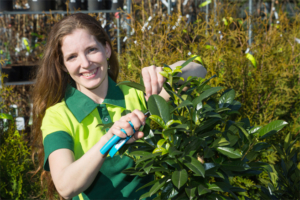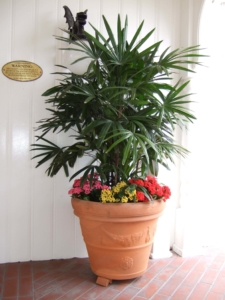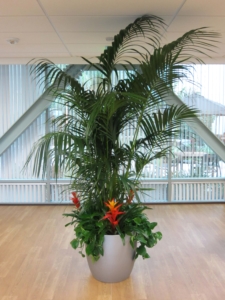Interiorscape Basics
Chapter Six: The Aesthetic Side of Interiorscaping
Grooming
Yellow leaf tips, perhaps ringed with brown…not a pretty sight. Other than a full-out wilt of a plant there really is no other sign that says more clearly to you, “I have not cared for this plant as I could have. It needs more from me.” On top of that, most everyone in your client’s office will surely notice, point and ask, “What are you doing wrong with that plant?” It is frustrating to see brown and/or yellow tips scarring the beauty of an interior plant. They stand out, distracting us from the grace and form of the leaf.

Grooming your plants keeps them looking great
This happens to everyone in the horticulture industry. You need to know what to do when it happens to you. If you do not correct the cause of the symptoms, they will continue to haunt you. Week after week you’ll be faced with more brown or yellow tips.
Tipping
Depending on the plant and how much of the leaf looks bad, you’ll need to decide whether to trim the leaf or remove it entirely. Does removing the tip really cure it? Won’t it just turn yellow again? With a sharp pair of scissors you can trim that bright yellow tip off and make a nice, less noticeable edge as long as you follow the general shape of the leaf when trimming. The rule of thumb for “trim or remove” is to leave the leaf if less than one fourth is discolored and on a plant with few leaves that needs the foliage. If you have to remove more than one fourth of the overall length of the leaf, it is better to remove the entire leaf. If you can remove several entire leaves without detracting from the shape of the plant, do so!

When should you remove a leaf completely?
Observing the Whole Plant
If you decide to trim, be very diligent in determining the cause of the tipping and providing a cure. It does nothing for you professionally or for the plant aesthetically, if you can’t stop the tipping. Solve the problem rather than simply dealing with the symptoms week after week.
Leaf tipping is a symptom of a host of problems. Do not look only at the leaves, look at the whole plant and the surrounding environment. It oftentimes boils down to water stress…sometimes you’ve given it too much water, sometimes too little. Or you gave it too little water a month ago and it wilted so you overcompensated and gave too much for the next three weeks. You need to learn to identify the problem behind the symptom and take corrective measures. Take a close look at the following table for guidance.
Look at All the Symptoms

Observe the whole plant
Your plant is trying to communicate with you and tell you that it is unhappy when leaf tips turn yellow or brown. It is a sign that something is wrong and needs correcting. Symptoms are clues that tell you when a plant is in distress. Really look at the plant. Explore the root zone, smell and feel the soil. How is the air…hot and dry? Did they recently paint, put in new carpets or otherwise cause a fume that may be bothering the plant? What clues are there for you? Closely examine the clues/symptoms and then determine a solution. Trim or prune off the damage so you’ll see if your corrective measures are paying off. You’ll know in a week or so if you solved the problem.
Proactive Service
Week after week you go to the same accounts. The plants become your friends and you become accepting of their flaws. The Spathiphyllum that droops when it gets hot outside and shows up with three or four yellow leaves the next week becomes predictable. Perhaps the big, full Ficus has become less than shiny with that protective coat covering its leaves.

Make sure your plants do not obstruct walkways
When you have been servicing an account for a period of time, you may lose your perspective on how the account really looks to your client and their guests. An interiorscape job site can slowly change with plants growing a bit haywire or losing their luster without your noticing simply because you have grown accustomed to its looks. Here is a list to get you to take a fresh look at your current accounts.
Does the plant:
- Obstruct walkways?
- Cover the artwork?
- Disrupt a view for conversation when the plant is on a table?
- Lay or lean over a person’s workspace or rest against a wall?
- Look over-sized with the furnishings?
- Crawl across the desk or onto the ground?
- Look perky and healthy?
- Look dusty or grimy?
- Have insects that are noticeable to the client?
- Need soil added to fill air pockets?
- Have roots growing out of the drainage holes?
Does the decorative container:
- Match the other containers in the room?
- Need replacing? (Is it cracked, scratched, broken, leaking?)
- Need cleaning?
- Need a pleximat?
- Sit level?
- Fit the plant? (Is it large enough to accommodate the plant without a rim showing?)
- Fit the scale of the job site?
- Complement the furnishings?
Does the top dressing:
- Cover the grow pots?
- Fall into the bottom of the decorative pot?
- Require additional dressing to give a fresh look?
- Have bugs in it?
- Have dead leaves in it?
Become a proactive interiorscaper. Take a moment to look at each account, each room, each plant and each container every visit. Dig in and straighten that cane, and wash and trim those stems and leaves. Fluff the ground cover and make it look new. While you are at it give that decorative container a clean swipe. As a final touch, check the centering on the trivet. Be critical. Be a fanatic. Before your supervisor has a chance to remind you or a client calls to complain about lack of service, get a jump on it and enhance your plants and their environment!
